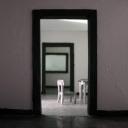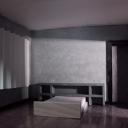This article is the research I undertook during the MA in Contemporary Fine Art.
The topic of this essay is the relationship between fantasy and reality, and the creation of images that deal with the use of fantasy to make us aware of the lack of imagination in real life. But because this is a huge area for investigation, in order to figure out which specific parts I want to focus on in my own practise I will compare works from different artists and explore how they have resolved that dialogue between the representation of fantasy and reality.
All the works I will be looking at are marked with the tension between the subject of representation and the fragility and proximity of the human crafting creation. The presentation will be divided in three parts that explore different aspects of this relation, for the first part I would like to approach the theme from a wider point of view…
Part I
I consider the cosmological image as the most significant scenario for imagination and fantasy. For this I would like to start with the example of Vija Celmins’s drawings of starry night skies and constellations. We are used to receive these scientific imagery as interpretation from computer data, resulting in visualizations of a world beyond our own direct physical perception; the charcoal drawings present us with the contradiction of the unreachable immensity against the proximity that the physical presence of the drawing suggests.
The density of the final image, the material used and their medium size serves to humanize the theme. They bring us back and forth from the completeness and successful resolution and the fragility of the hand made crafting. The final painting is a record of its own process, it talks about inner time in a parallel way as the cosmos image talks about distance. Through the medium of drawing there is an interiorization of the subject. The success of the artists as a creator emphasizes our real distance to the subject, therefore maximizes the feeling of isolation and the impossibility of physically inhabiting the space portrayed.
In my own work I tried to explore the relation between reality, memories and fantasy. As Roland Barthes explains in his book Camera Lucida, the desire for inhabiting and in a way forming part of the image is neither oneiric nor empirical; it is fantasmatic, deriving from a kind of a second sight which seems to bear me forward to an utopian time, or to carry me back to somewhere in myself . Although he refers to photography I think we can apply that concept to the starry night drawings of Vija and also, this work. Our impulse for inhabiting is only part of the illusion.


Uninhabited, 2006
These landscapes are already loaded images, so through representing them in that way, eroding the image, I tried to emphasize the distance between the viewer and the space represented, to underline their artifice, their constructiveness. As Susan Stewart says in her book On Longing when she talks about our relation with the miniature, as with these images, all our senses must be reduced to the visual what makes us remain ironically and tragically remote to the subject represented but also to its real referent by correlation .
Part II
Here I like to start a new part of in this research, and narrow my analysis to the use of reconstructed spaces in miniature specially to be photographed. There is a concept very important present in all these works that is the fascination with other worlds that are unrepresentable or inaccessible, like the miniature; which with its physical impossible scale, appeals to our imagination and psychological projection into its idealized representation. The seductive and manipulability quality of these reproductions becomes an instrument for artists to construct a parallel relation with reality.
“Such formulas as being-in-the-world and world-being are too majestic for me and I do not succeed in experiencing them. In fact, I feel much more at home in miniature worlds, which, for me, are dominated worlds” . Gaston Bachelard’s book The Poetics of Space is directed to the dreamer when he analyzes our perception of spaces (from every corner of the house to spaces of immensity, like desert, ocean) and their influence in our memories and dreams, although his approach may be a bit dated, I find a correlation of his reflection about the miniature when I look at the work of Walter Martin and Paloma Muñoz.
This couple of artists work together creating miniature sets and then photographing them, the sets are tableau like scenes, but their nature seem to contradict their style of highly constructed fake-ness. Their snow globes (which they exhibit as objects as well as photographs like this one), present us with a new contradiction, the display glass (in this case the bubble of the snow glass) works as a boundary with a double function, it emphasizes the distance and remoteness of the idealized world within it, but also protects that world to be contaminated by the grotesque of human reality…The glass eliminates the possibility of contagion, indeed of lived experience, at the same time maximizes the possibilities of transcendent vision .
But in these works, the world contained within the glass seems to be already contaminated, the nature of the frozen action that is represented is not the perfect and idyllic that we could expect, which blocks our longing to inhabiting them. And yet again there is another contradiction, because the figures inhabiting those scenarios are a miniaturization of ourselves, and thus we are already by force inhabiting the image. As it happens in Vija’s drawings, the hand-made feeling of these stages serves to humanize their non-realistic character and their inconsistencies are forgiven because of their fragility.
The miniature does not attach itself to lived historical time, and as an object consumed, the miniature finds its “use value†transformed into the infinite time of reverie. The miniature is a world of arrested time; its stillness emphasizes the activity that is outside its borders . Because of its seductive quality and visual power mentioned before, the miniature becomes a much stronger subject to engage the viewer. The use of fantasy and miniature in those works is used to expose our real nature. The frozen scenarios of unchangeable action underline the action beyond their glass sphere.
The chosen medium of Photography in the works produces an extra level of removal and distance between viewer and action. The photograph’s immobility is somehow the result of a perverse confusion between two concepts: the Real and the Live; as Roland Barthes comments on Photography: “by attesting that the object has been real, the photograph surreptitiously induces belief that it is alive, because of that delusion which makes us attribute to Reality an absolutely superior, somehow eternal value; but by shifting this reality to the past (“this-has-beenâ€), the photograph suggests that it is already dead†.


On Waiting, 2006
In other of my projects I am photographing my dollhouse’s room, experimenting with the lighting and the position of the camera to create ambiguous spaces. The photograph shows a reality that was once in front of the lens, therefore distances us from it in time and space (“That has beenâ€), but in this case, that reality was already a fake, a manipulable reconstruction of reality, the loss of sense of scale that the photograph produces increases the mystery of its existence and the possibilities of grasping and manipulating it…The stillness of the miniature space is multiply by the function of Photography that freezes the moment and existence of the object, offering a co-presence with its reality and inviting us to psychologically inhabit it.
Part III
In very close relation with this concept of psychologically inhabiting an image are the works of Saskia Olde Wolbers, which serve me to introduce the last part of my presentation, the moving image, and the license that this medium allows to create the most dramatic use of the fantasy element to talk about its absence.
Based on true stories that are narrated at the same time as the camera moves through the miniature sets created by hand by the artist. Their materiality and fantastic resolution allows the viewer to enter the image and the illusion, but the voice-off narration remind us of their fragility as mental images, and the impossibility of entering the reality of the human psychology. All these images are representation of experiences that are un-representable or too abstract for us to experiencing them and they are reached only through imagination.
Moving slightly within this area of moving image, or rather, expanding it, I would like to focus the medium of cinema. In cinema the whole concept of psychological inhabiting becomes more physically experience through the immersive character of attending to the cinema screen, but for this particular research I will concentrate only in the images. The next example I think is the most intelligent and yet crude and extreme use of fakeness and artifice to expose reality and the lack of “magic†in the world: Charles Laughton’s The Night of the Hunter.
All the extremely highly constructed scenarios where the movie develops its action are a metaphor on the untruth of the medium itself, cinema. Because they are inhabited by figures there is an intense dramatization of the action. And likely as happened with the snow globe pieces, when all these contradictions accumulate everything becomes alive .
The director takes the license of not representing the drama in a realistic way; the movie represents emotions and the psychology of the characters and not the facts. The resulting images are full of ambiguous beauty; there is a tension between the artifice and the action. The aesthetics is the result of conscious and rational decisions to expose in a much more effective way the reality of human nature. This contrasts with the highly realistic way of representing drama in the rest of movies and the access through television to real dramatic events, because of the distance between the real action and the audience mediated through the screen, the boundaries between fact and fiction are blurred.
As my last example for this research I would like to refer to the movie Nostalgia by Andrei Tarkovsky, because it sums up all the ideas I have talked about. It is a highly constructed scenario, inhabited by a character that through its still pose looks at us directly in the eye making us inhabitants of the image in a complicit way, and again its ambiguous and unsettling beauty talks about psychological depths.
After having looked at all these works, there are huge similarities in relation to each other and in relation with my own practise. Their constructed fictiveness highlights the emotional character of the events staged or in the case of Vija’s drawings and in the works where there are no figures, the metaphysical meaning of the place and the symbolism of the landscapes. There is a feeling of an almost desperate attempt to represent and reproduce the un-representable, to make the imagined become real. Their inconsistent existence is redeemed with their uniqueness and humanized fragility. The drawing, the miniature and the theatrical sets all remain tragically remote and unreachable in their display exposure.
They all use the technique of constructing and fabricating unreal worlds; creating images that produce pleasure in an unsettling way, to make us feel guilty for admiring its beauty. The narrative is fragmented giving room for the viewer to imagine and project itself into the picture, but this inhabitancy of the image is an abstract experience, as any fantasy or fictiveness experience in general, and it is only known through representation, there is no original. That is what I seek to explore in my own practise, to create a parallel between the promise of perfection enclosed in these constructed images that can never be fulfilled, and the isolation and imperfection of the world that surround us.